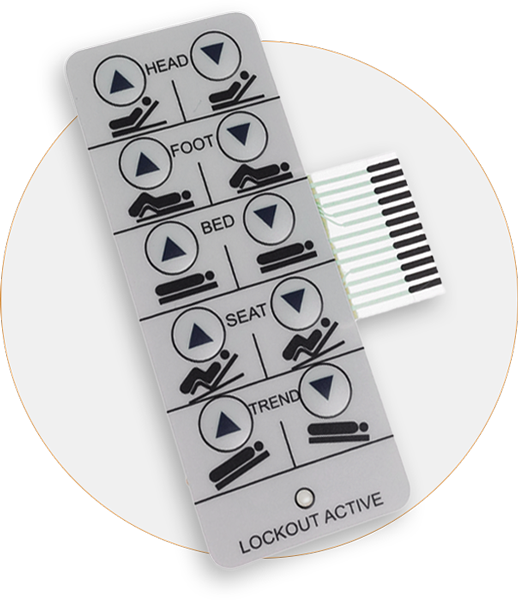Top Advantages of Integrating a Membrane Switch Into Your Digital Equipment
Top Advantages of Integrating a Membrane Switch Into Your Digital Equipment
Blog Article
Comprehending the Capability of Membrane Layer Changes for Interface Gadget
The functionality of membrane layer switches over represents a considerable development in interface design, integrating efficiency with aesthetic versatility. These switches run through a multi-layered framework that equates individual interactions into electric signals, allowing for both compact designs and strength versus ecological factors. As sectors increasingly prioritize user experience, recognizing the subtleties of membrane layer switch technology becomes important. What implications do these developments hold for future applications, and just how might they redefine individual interactions across different tools?
What Are Membrane Switches?
Membrane layer switches are ingenious user interface devices that facilitate user interaction with digital tools. These versatile parts contain several layers, including a visuals overlay, spacer, and a published circuit layer. The style permits for a smooth integration into numerous electronic tools, boosting both the aesthetic and practical facets of interface.
Membrane switches are generally utilized in a large range of applications, from house appliances to commercial machinery and clinical devices. Their building and construction usually includes a thin profile, making them an optimal selection for compact styles. The responsive responses provided by these switches can be crafted to satisfy specific customer preferences, ensuring efficient communication in between the customer and the gadget.
Longevity is another considerable advantage of membrane buttons, as they are immune to dirt, dampness, and chemicals, which boosts their life-span popular settings. Furthermore, these switches can be tailored in regards to shape, dimension, and visuals design, permitting branding and user-specific functions. Overall, membrane layer switches stand for a useful remedy for boosting customer experience in digital tools, incorporating performance with aesthetic charm in an efficient way.
Just How Membrane Switches Job
Operating on a straightforward concept, membrane layer switches over make use of a layered building and construction to sign up customer input efficiently. Each button is composed of numerous layers, including a printed circuit layer, a spacer layer, and a top graphic layer, which are designed to collaborate perfectly. When a customer presses the top layer, it compresses the spacer layer, bringing the conductive aspects of the circuit layer into call with each other.
This call creates a shut circuit, indicating the tool to implement a particular function. The style enables numerous setups, including tactile responses, which can boost the individual experience by providing a physical experience upon activation. The materials utilized in membrane switches usually consist of flexible substratums, such as polyester or polycarbonate, which guarantee durability and resilience against deterioration.

Key Benefits of Membrane Layer Buttons

Another significant advantage is their density. Membrane layer switches are thin and lightweight, which enables manufacturers to save room in their gadgets without compromising performance. This attribute is especially useful in applications where weight and volume are vital factors to consider.
In addition, membrane layer switches are immune to dirt, dampness, and chemicals, boosting their sturdiness. This durability expands their life expectancy and minimizes the requirement for regular substitutes, causing price savings over time.
Additionally, the tactile feedback provided by membrane layer buttons can be maximized to improve user interaction. They can include attributes such as raised switches or audible clicks, enhancing usability and customer experience.
Applications Across Industries
Individual interface devices making use of membrane layer buttons are common in a broad array of industries, showcasing their flexibility and performance. Membrane Switch. In the medical industry, membrane buttons are indispensable to tools such as diagnostic devices and person surveillance systems, where their sturdiness and simplicity of cleaning are critical for maintaining health standards. In the automotive industry, these switches are utilized in control panel controls and infotainment click here for info systems, giving a streamlined and contemporary user interface for individuals.
Furthermore, the customer electronics industry gain from membrane switches in devices and handheld gadgets, where small design and straightforward interfaces enhance user experience. Industrial applications also take advantage of membrane changes for control panels in equipment and automation systems, emphasizing their toughness and resistance to rough settings.
In the aerospace and defense markets, membrane layer buttons are used in cabin controls and equipment, where integrity and efficiency under extreme problems are vital. Furthermore, the video gaming sector significantly incorporates membrane buttons in controllers and arcade devices, adding to discover this info here an appealing user experience. On the whole, the adaptability of membrane layer switches over enables their widespread usage across various fields, highlighting their importance in modern-day individual interface layout.
Future Patterns in Membrane Switch Over Innovation

In addition, making use of sophisticated products, such as polycarbonate and polyester films, is anticipated to climb, supplying improved sturdiness and resistance to ecological stress factors. These products add to the general long life of membrane layer switches, making them suitable for harsher industrial applications.
Additionally, the unification of wise site link technology, consisting of IoT connectivity, will make it possible for membrane layer switches to communicate with other devices and systems, promoting a much more interactive user experience. This fad straightens with the expanding demand for wise devices across numerous fields, from health care to consumer electronics.
Finally, personalization options are prepared for to expand, allowing manufacturers to develop bespoke remedies tailored to specific individual needs and preferences. These advancements will position membrane layer buttons as important elements in the development of interface technology.
Verdict
Finally, membrane switches over represent a crucial improvement in individual interface technology, supplying a reputable and functional option for varied digital applications. Their layered construction assists in compact style, while features such as responsive feedback boost individual communication. The resilience against ecological aspects even more solidifies their utility across several markets. As improvements in product science and touch sensing technologies continue, the capability and applicability of membrane layer buttons are anticipated to broaden, reinforcing their importance in modern-day electronic tools.
Report this page